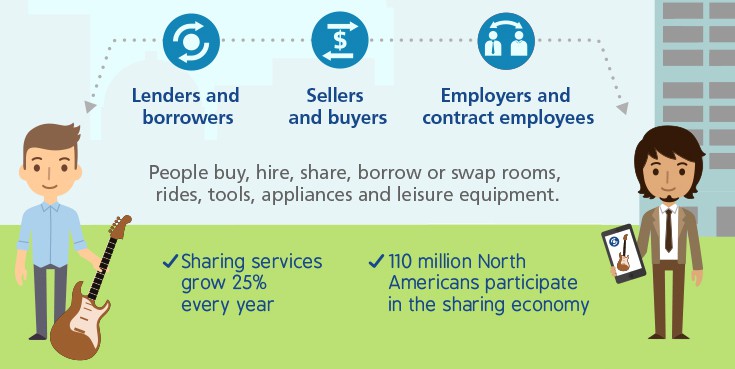Long before the phrase “the sharing economy” was ever uttered, many businesses leveraged sharing. Bed-and-breakfast inns, timeshares and car pools are old ideas.
What’s different about the sharing economy is that technology has allowed organizations to coordinate products and services on a much larger scale.[1],[2] It used to be that you were limited to your own village for the stuff you could rent, borrow or buy. Today, the village is global.
Collaborative consumption and the peer economy are also used to describe the benefits of use without the hassle of ownership. Technology connects lenders and borrowers, sellers and buyers, employers and contract employees.
Adoption of sharing services has grown at least 25 percent annually, and more than 110 million people in North America are part of the sharing economy.[3] As people conduct more of their lives online, this business trend is likely to become more ubiquitous.
Organizations can take advantage of business models and technology inspired by collaborative consumption. The sharing economy is surging; and new and established businesses can leverage its lessons to increase competitiveness and profitability.
Sharing economy 101
What is the sharing economy in a nutshell? In the sharing economy, people rent (among other activities) from each other. Transactions are coordinated by Internet technology.[4] Instead of only being able to reach out to your next-door neighbors for help, you can reach out to anyone who’s online. The sharing economy helps participants monetize their assets.
In the sharing economy, owners rent something they’re not using via a peer-to-peer service. The service has a rating system so that owners and renters can learn about each other and build trust.[5] Technology that enables this communication is what all sharing economy organizations have in common.
Lenders and borrowers, sellers and buyers, employers and contract employees
People buy, hire, share, borrow or swap rooms, rides, tools, appliances and leisure equipment. Sharing services grow 25% every year and 110 million North Americans participate in the sharing economy.
The sharing economy, however, is about more than the act of sharing. It’s a bucket term for several types of peer-connection business services. In general, there are five sharing economy activities:[6]
- Buying things
- Hiring people to do things
- Sharing things
- Borrowing things
- Swapping things

The posterchild of the sharing economy is Airbnb®, which helps travelers rent a place to stay—from single rooms to whole castles—directly from people who live in their destination. Other examples of sharing economy businesses include RelayRides® (peer-to-peer car rental) and Fon℠ (global Wi-Fi network powered by people who share part of their own Wi-Fi).[7] While their products and services may be different, these organizations all rely on Internet technology to connect a community of users.
The appeal of sharing is growing. Research from Ericsson®, a global telecommunications firm, found people were very interested or open to the idea of using a smartphone app to:[8]
- Eat dinner in other people’s homes (46 percent)
- Rent other people’s household tools and appliances (51 percent)
- Rent rooms in other people’s homes (57 percent)
- Rent other people’s leisure equipment (58 percent)
How the sharing economy works—and why people love it
The sharing economy is growing, and companies that can leverage technology to scale are winning. Uber™, the ride-finding app, is valued at $51 billion, and Airbnb is valued at $25 billion.[9], [10] There’s a lot of money to be made in the sharing economy.
The combination of efficient technology and reliable product is critical to sharing-business success. If technology defines the sharing economy, trust is its foundation. For collaborative consumption businesses, trust is “the beginning, middle and end of the story.”[11] User-to-user reviews, troubleshooting, photos and word of mouth can build—or erode—trust in a sharing economy business.
In the sharing economy, customers love businesses whose products are trustworthy and dependable. And these businesses are rewarded with patronage. At a higher level, there are four main reasons why the sharing economy is beloved by consumers:
- Savings: Customers pay less than what they would have paid if they had bought new or through a traditional seller.[12] What’s more, in the sharing economy, saving money is more appealing than making money.[13] The bottom line is that the bottom line matters.
- Access: Access to products and services is more important than ownership.[14] Instead of the sharing economy, the phenomenon is sometimes called the access economy.[15] Using something is more important than calling it your own.
- Monetization: Sharing economy lenders make money on underused assets.[16], [17] Instead of gathering dust, these perfectly functional possessions become income machines.
- Conservation: Sharing benefits the environment by reducing waste and manufacturing.[18] Research shows that saving resources, however, is less important than removing the inconvenience of ownership.[19] Decreased production, regardless of your motivation, is a byproduct of the sharing economy.
Page 1 of 3
